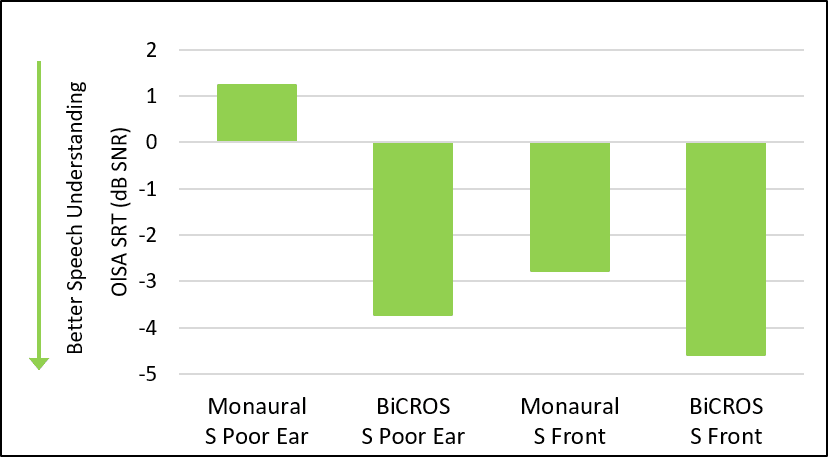Tech Topic | December 2018 Hearing Review
Single-sided deafness (SSD) is characterized by a substantial loss of functional hearing ability in one ear, to the extent that amplification provides little or no benefit on that side. While many patients with SSD have normal to near-normal contralateral hearing ability, the condition frequently occurs with hearing loss also present in the better ear.
Overall, the findings of this study demonstrate that the two new CROS/BiCROS systems from Signia—the Pure 312 Nx CROS with Narrow directionality and the Silk Nx CROS—provide a superior solution to the daily listening problems encountered by people with single-sided deafness (SSD).
People with SSD experience a unique array of auditory challenges. One prominent difficulty is the reduced audibility of sound originating from the side of the patient’s worse ear. This occurs due to the “head-shadow effect,” where the level of sound originating on the side of the bad ear is attenuated as it travels around the head to the better hearing ear. This effect is more pronounced at the higher frequencies important for speech understanding, making communication with talkers facing the patient’s worse ear especially difficult.
In addition to reduced sensitivity to sound on the side of the bad ear, the loss of binaural acoustic information results in further deficits. Speech understanding in noise is significantly worsened and sound localization ability also is significantly impaired.
Effective non-surgical solutions for problems associated with SSD are CROS (Contralateral Routing of Signals) and BiCROS (Bilateral CROS) systems. The CROS consists of a bilateral hearing instrument fitting in which sound detected from the device worn on the poor ear is transmitted to the device worn on the better ear. The users are then able to perceive sound originating from their poor-ear-side in the good ear, thus overcoming the head-shadow effect.
In a CROS fitting, there is typically no direct amplification of sound entering the instrument worn on the better ear. For SSD patients who also have a hearing loss in their better ear, BiCROS systems provide amplification for sound arriving at the microphone of the better ear instrument, enabling compensation for the additional hearing loss on the patient’s “good” side.
Sizable technological leaps in CROS and BiCROS fittings have been made since the early inception of the method in the 1960s, when connectivity between bilaterally worn devices was only possible using wire-based electrical contacts. Following the introduction of e2e Wireless 3.0 technology by Sivantos in 2014, considerable advances in hearing aid binaural beam-forming technology have been achieved. This development significantly improved speech understanding in background noise, even for situations where speech originates from azimuths other than in front of the user.1
With the launch of the Signia Primax platform in 2016, this technology was integrated into a highly effective wireless CROS/BiCROS solution. The performance of the Primax CROS/BiCROS system for both speech-in-noise benefit and user satisfaction was reported by Petrausch et al.2 In addition to a measurable speech-in-noise (SNR) intelligibility benefit of over 5 dB, the study found that users gave highly preferential ratings to the Primax system over that from a leading competitor, in areas including speech understanding in quiet and noise, sound quality, and localization ability.
Two New Options for SSD Hearing Aid Fittings
Pure 312 Nx with Narrow Directionality for BiCROS. A subsequent technological development has been achieved in the Signia Nx platform with the addition of Narrow Directionality to BiCROS, which is designed to further enhance the selective directionality of BiCROS fittings for noisy listening situations, in a receiver-in-the-canal (RIC) hearing aid.
Silk Nx, new CROS/BiCROS solution for CIC hearing aid users. The introduction of the Signia Silk devices with click sleeves reflects a new concept in the development of CIC fittings. These instant-fit CICs combine the advantages of in-the-ear (ITE) instruments with the ease of the fitting process of a ready-made device (T. Lotter, white paper, “Silk and Click Sleeves–A New Concept for In-the-Ear Fittings,” 2016). With the addition of CROS/BiCROS functionality and a reduction in size of 20%, the new Silk Nx delivers the performance of the CROS/BiCROS solution from Signia Nx in a system tailored for the specific needs of the modern CIC user.
Study Methods of Two Field Trials
![[Click on figures to enlarge images.] Figure 1. Mean air conduction hearing thresholds of the study participants, in dB HL. Results for the good and poor ears are shown in green and blue, respectively. The error bars represent ±1 standard deviation.](https://hearingreview.com/wp-content/uploads/2018/11/Littmann_HR_Figure_1_NEW-300x262.jpg)
[Click on figures to enlarge images.] Figure 1. Mean air conduction hearing thresholds of the study participants, in dB HL. Results for the good and poor ears are shown in green and blue, respectively. The error bars represent ±1 standard deviation.
BiCROS fittings were tested using Signia CROS Pure 312 Nx and Silk Nx CROS hearing aids. Coupling to the ear was accomplished using standard Signia closed click sleeves. The hearing instruments were fitted to the individual audiograms of the participants using the NxFit fitting formula for experienced hearing aid users. All sound processing features were left at the default settings. The results of the BiCROS fittings were compared to results obtained with a conventional monaural fitting on the better ear.
Pure 312 Nx CROS – BiCROS with Narrow Directionality
For the BiCROS fittings in this study, Signia CROS Pure 312 Nx hearing aids were used on the poor ear and Signia Pure 312 7Nx M receiver hearing aids on the better ear. Switching between different directional modes was achieved using the spatial configurator in the Signia myHearing App.
Experimental method. To evaluate the performance of Narrow Directionality in a BiCROS fitting, a similar method to previous studies such as Froehlich et al,3 Littmann and Høydal,4 and Mejia et al5 was used. Speech recognition was evaluated in four different conditions. These included omni and conventional directionality with the CROS device turned OFF (monaural fitting), and conventional directionality and Narrow Directionality with the CROS device turned ON (BiCROS fitting).
The speech material used was the Oldenburg Sentence Test (OLSA), with the target speech material presented from a front loudspeaker (0° azimuth) at a distance of 1 meter from the participant. The competing signal consisted of the same speech material without gaps between the sentences, with added cafeteria noise. This competing signal was presented from seven speakers surrounding the participant, with an angular displacement of 45° between adjacent loudspeakers (excluding the front loudspeaker). A fixed random starting offset was used for the sound presented from each loudspeaker to create a constant noise babble. The combined background noise was 68 dBA at the position of the listener.

Figure 2. SRT-in-noise results in dB SNR, for the four fitting conditions examined using Pure 312 Nx CROS/BiCROS devices.
Results and discussion. For SSD patients, a BiCROS solution not only provides much-needed support in situations where speech or other meaningful signals come from the poorer-ear side, but it also offers the benefit of the bilateral audio data sharing of the hearing instruments. The results in Figure 2 show that, as expected, adaptive directionality already improves speech understanding by a substantial 4 dB SNR compared to omnidirectional processing. With the addition of Narrow Directionality, however, a further significant speech intelligibility benefit of 2 dB SNR was achieved (two-tailed paired t-test, p<0.001).

Figure 3. Speech intelligibility improvement in dB SNR for three different comparisons: Adaptive directional mode relative to the omnidirectional mode, Narrow Directionality relative to the adaptive directional mode, and Narrow Directionality relative to the omnidirectional mode. Mean results for the five best-performing and five worst-performing participants in the Omnidirectional condition are plotted in blue and green, respectively.
In agreement with previous studies,3,4 it was found that participants who had the greatest difficulty in the omni condition tended to show the highest benefit with adaptive and Narrow Directionality. These results are illustrated in Figure 3, which compares the speech intelligibility improvement (in SNR) of different microphone modes. Illustrated are the mean results for the five best-performing and five worst-performing participants in the Omnidirectional condition, plotted in blue and green respectively. Among the 5 “worst-performing” participants, the 8 dB mean SNR advantage of Narrow Directionality is particularly noteworthy. This highlights that it is worthwhile to not only look at means but also at individual performance. Patients who struggle most also seem to gain the most by using the advanced hearing aid features.
Silk Nx CROS/BiCROS
The second CROS/BiCROS solution offered by Signia is the Silk Nx CROS/BiCROS. For this part of the study, a Signia CROS Silk Nx hearing aid was used on the participant’s poorer ear, and a Signia Silk 7Nx on the better ear.
Experimental method. Conversation situations for listeners with SSD can be challenging in different ways. While for the Pure Nx devices, the focus was on speech understanding in a very demanding noisy environment, the focus of the Silk Instant Fit CIC study was a different situation that also is particularly difficult for these patients: where the hearing-impaired individual talks to several people in a group. In a one-to-one conversation, persons with SSD typically position themselves in a way so their good ear is turned towards the conversation partner. In a conversation with a group of people, however, the patient cannot always predict from which side the next speech signal will arrive, making the task very difficult.
To simulate this situation, speech understanding was tested using a special matrix test, the interleaved Oldenburg Sentence Test (OLSA), in which the target speech was presented randomly from either the front (0°) or from the poorer-ear side (90° or -90°, depending on the “bad” ear of the participant). During one test run, two lists of 20 sentences were completed, with one for each position. OLSA noise was presented from three speakers in the frontal plane, at +45°, -45°, and +90° or -90° (ie, diametrically opposite the poor ear of the participant), resulting in a diffuse noise field. The combined background noise was 55 dBA at the position of the listener. The task was conducted twice: once with a BiCROS fitting, and once using a standard monaural fitting on the better ear.

Figure 4. Left: illustration of the calculation of the visibility range. Right: Exemplary subset of photos for one subject. A) Start visibility at 66°; B) Full visibility at 87°; C) end visibility at 110°. Visibility range is determined by calculating the difference between A and C.
The Silk Nx devices are 20% smaller than their predecessors and—together with the newly introduced XS click sleeves—designed to be even less conspicuous than their predecessors. For this reason, an additional experiment was conducted with 20 participants. The subjects were fitted with Silk Nx as well as Silk px, selecting the appropriate click sleeve, and photos were taken of the ear from different angles (spacing ~10°), as demonstrated in Figure 4. Nine audiologists were presented with the photos in randomized order (Silk px and Silk Nx mixed) and were asked to judge if the device was visible or invisible in the ear. Based on these judgments, the visibility range was calculated for each instrument.

Figure 5. SRT-in-noise results in dB SNR, for the four fitting conditions examined using the Silk Nx devices. Left to right: monaural fitting with speech arriving from the poor-ear side, BiCROS fitting with speech arriving from the poor-ear side, a monaural fitting with speech arriving from the front, and a BiCROS fitting with speech arriving from the front.
Results and discussion. The results of the OLSA speech recognition test can be seen in Figure 5. As would be expected, understanding is worst when the speech arrives from the participant’s poorer-ear side and the participant does not have a BiCROS solution. Enabling the BiCROS device overcomes this problem completely, improving the speech reception threshold on average by 5 dB SNR (paired t-test, p<0.0001). Speech understanding in this condition is, in fact, similar to the situation where the primary speech signal is in front of the participant. When speech is presented from the front, the difference between the BiCROS fitting and a monaural fitting for speech understanding is smaller. The BiCROS solution, however, still results in a significantly improved understanding of nearly 2 dB SNR, by combining relevant information from both sides. An additional factor could be the slightly asymmetrical set-up that was chosen to enable the interleaved OLSA. A somewhat better SNR exists at the poorer ear because the noise source located next to the good ear is attenuated by the head-shadow effect.

Figure 6. Mean subjective ratings of listening effort for the BiCROS and monaural fitting conditions. A 7-point rating scale was used.
Looking at the results in Figure 5, one can see that with a BiCROS fitting, the speech reception threshold (SRT) for speech arriving from the front is still better than if speech arrives from the poor-ear side. This could be attributed to the pinna effect and the fact that speech coming from the front is more highly correlated between both sides, resulting in a better SNR.
Using the same speaker set-up and stimuli, the participants were also asked to provide a subjective rating of listening effort. For this task, the speech was always presented from the poorer-ear side at a fixed SNR. The SNR was set to the individual mean of the SRTs (ie, the SNR at which 50% of speech was understood) for the monaural and BiCROS conditions from the previous experiment. The rating scale used consisted of seven steps ranging from “no effort” to “extreme effort.” The results were clear: without CROS, participants judged that it was very difficult for them to understand speech, whereas with the BiCROS solution, speech understanding was rated as requiring only little to moderate effort (Figure 6).
The results of the visibility experiment further corroborate the discreet characteristics of the Silk Nx devices. The new design resulted in a 21% reduction in the angular range of visibility (Figure 7), making it invisible for most viewing directions. This corresponds nicely to the 20% size reduction compared to the Silk px.
Summary and Conclusions
Patients with SSD often experience significant problems with speech understanding in daily listening situations where noise is a factor. The results of this study demonstrate that the two latest CROS/BiCROS solutions offered by Signia—the Pure 312 Nx CROS with Narrow Directionality and the Silk Nx CROS—provide clear and significant speech intelligibility benefits in challenging listening environments.
The Pure 312 Nx CROS provides a highly effective and reactive CROS/BiCROS system in the established RIC format. In our study, this alone was shown to provide a benefit of 4 dB relative to a conventional monaural fitting. However, with the addition of Narrow Directionality, this benefit was further increased to 6 dB. Translating this to real-life benefit, this represents a significant help to users with SSD who usually struggle to understand speech against the negative effects of competing noise—a 6 dB SNR improvement can result in a speech understanding benefit of 50% or more for many listening situations.
The Silk Nx CROS offers a CROS/BiCROS solution with all the benefits of the CIC form factor combined with the fitting flexibility and efficiency of a RIC product, made possible through the use of click sleeves. With this system, intelligibility in noise for speech arriving from the bad-ear side was shown to be improved by a SNR of 5 dB, when compared to a standard monaural fitting. Furthermore, the algorithmic combination of sound components from the binaural device pair provides a benefit of 2 dB relative to a monaural fitting, even for sounds arriving from the front. The results of the subjective ratings are equally clear: the solution was perceived to provide a substantial reduction in listening effort, from an average rating between “very much” or “extreme” effort before the fitting, to close to “little effort” afterwards.
In addition, it was shown that visibility of the Silk Nx has been reduced by 21% compared to the Silk px, making it exceptionally discreet.
Overall, the findings of this study demonstrate that the two new CROS/BiCROS systems from Signia, the Pure 312 Nx CROS with Narrow directionality and the Silk Nx CROS, provide a superior solution to the daily listening problems encountered by patients with SSD.
References
-
Littmann V, Junius D, Branda E. SpeechFocus: 360° in 10 Questions. Hearing Review. 2015;22(11):38. Available at: https://hearingreview.com/2015/10/speechfocus-360-10-questions
-
Petrausch S, Manders A, Jacobus K. A new CROS and BiCROS wireless solution. Canadian Audiologist. 2016;3(4). http://www.canadianaudiologist.ca/a-new-wireless-cros-and-bicros-solution
-
Froehlich M, Freels K, Powers T. Speech recognition benefit obtained from binaural beamforming hearing aids: comparison to omnidirectional and individuals with normal hearing. May 28, 2015. Available at: https://www.audiologyonline.com/articles/speech-recognition-benefit-obtained-from-14338
-
Littmann V, Høydal E. Comparison study of speech recognition using binaural beamforming narrow directionality. Hearing Review. 2017; 24(5):34-37. Available at: https://hearingreview.com/2017/05/comparison-study-speech-recognition-using-binaural-beamforming-narrow-directionality
-
Mejia J, Carter L, Dillon H, Littman V. Listening effort, speech intelligibility, and narrow directionality. Hearing Review. 2017; 24(1):22-24. Available at: https://hearingreview.com/2017/01/listening-effort-speech-intelligibility-narrow-directionality
About the Authors: Veronika Littmann, PhD, is the team lead of R&D Audiology System Development Team for Sivantos GmbH in Erlangen, Germany. She holds a PhD in Neurophysiology from Cambridge University. Alastair Manders, PhD, has an MS in Audiology and a PhD in Audio Signal Processing, and works in R&D at Sivantos GmbH.
CORRESPONDENCE can be addressed to HR or Dr Littmann at: [email protected]









Hi,
What is the citation for this please?
Littmann V, Manders A. Novel benefits in CROS and BiCROS hearing aid fitting technology. Hearing Review. 2018;25(12)[Dec]:32-35.